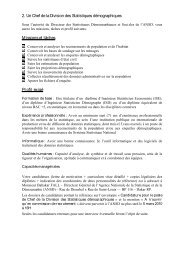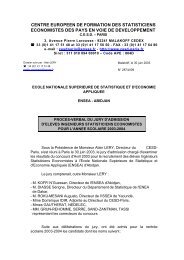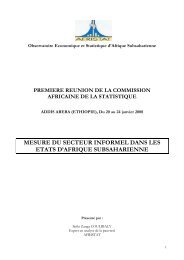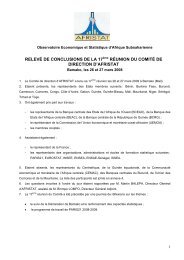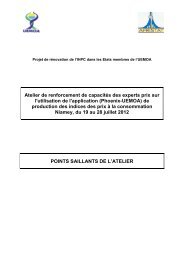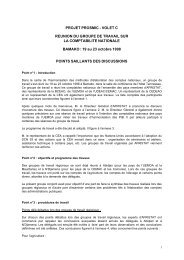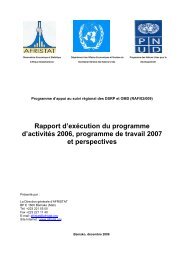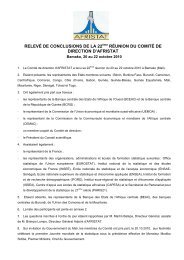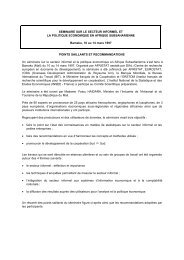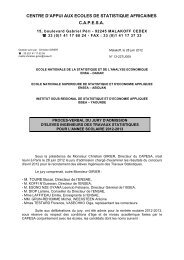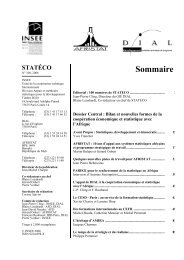Global Purchasing Power Parities and Real Expenditures - Afristat
Global Purchasing Power Parities and Real Expenditures - Afristat
Global Purchasing Power Parities and Real Expenditures - Afristat
Create successful ePaper yourself
Turn your PDF publications into a flip-book with our unique Google optimized e-Paper software.
188 <strong>Global</strong> <strong>Purchasing</strong> <strong>Power</strong> <strong>Parities</strong> <strong>and</strong> <strong>Real</strong> <strong>Expenditures</strong>for either equipment or compensation. After eliminatinganother four with poor quality data, 27 countries with completedata remained. PLI data for these countries were usedto estimate the following model by ordinary least squaresregression, as in equation (F1):PLI (Y) = a1 PLI (X1) + a2 PLI (X2),where Y is construction, <strong>and</strong>X1 <strong>and</strong> X2 are equipment <strong>and</strong> compensation.(F1)No constant term was included, on the premise that theprice of construction should go to zero as the prices of theinput variables go to zero. Using the estimated regressioncoefficients (a 1<strong>and</strong> a 2), the missing values of the constructionPLIs were imputed using actual data on equipment<strong>and</strong> compensation, where available, or the imputed values,where necessary.Equipment. Out of 48 participating economies in theAfrica region, 32 submitted equipment prices; for theremaining 16, the exchange rate to the base country (SouthAfrica) was used as a reference PPP on the grounds thatmost construction machinery <strong>and</strong> equipment are obtainedthrough international purchases. No further adjustmentswere made to account for taxes, tariffs, <strong>and</strong> other chargesbecause countries were not able to produce consistent data.In addition, some countries provide rebates for the taxes,which makes the relative prices close to exchange rates.Salaries. Forty-one countries provided data on governmentcompensation. For the seven missing countries, thePLI for government compensation was imputed from thenominal individual consumption ratio. (The nominal individualconsumption ratio is the value of a country’s individualconsumption per capita [in U.S. dollars] divided by thesame for the base country.) This procedure was adoptedon the premise that the level of compensation determines,in large part, the level of individual consumption; hence,the level of nominal compensation should reflect that ofconsumption. The imputed PLIs were used in the imputationof the construction PLI for the five countries thatlacked both construction <strong>and</strong> compensation data. The missingseven PPPs for government compensation were derivedas the product of the individual consumption ratio <strong>and</strong> theexchange rate to the base country.No data, except nominal expenditures from the nationalaccounts, are shown for the equipment <strong>and</strong> constructionaggregates for economies where results were imputed. Thegross fixed capital formation (GFCF) aggregate is footnotedwhere the individual components were imputed.Nonprofit Institutions ServingHouseholdsIndividual consumption expenditures by nonprofit institutionsserving households (NPISHs) were combined intoone basic heading in the ICP 2005 classification. However,participating economies were not able to consistently provideexpenditures for this basic heading; therefore, NPISHexpenditures in some regions could not be separated fromthe expenditures in other consumption categories, makingit difficult to ensure that basic headings were being consistentlydefined.Aggregation to GDPEstimation of PPPs for higher-level aggregates of GDP infive regions <strong>and</strong> the ring were based on the EKS method.Africa alone used the Iklé method, which provides resultswith additivity. Even though the Iklé method’s results cancontain some Gerschenkron effect, the Africa Iklé resultsin general were quite close to the EKS. The region desiredthe additivity restriction because it is easier to explain tousers how to construct aggregates <strong>and</strong> subaggregates ofGDP volumes.



